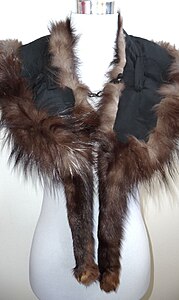Wave collar
The term wave collar seems to be preferred in the fur industry . The name describes a woman's fur collar, which has a lush wave-like fall in the outer edge of the collar. The designation as a wave collar is mainly used for loose fur collars of this form, but can also describe any other bell-shaped collar of a fur or textile item of clothing. At the time when wavy collars and fur necklaces (collars in the shape of animals) were particularly fashionable, the fox wavy collar was often extended downwards with the front paws and the two halves of the collar were only held next to each other by intertwining and pinning the rear paws together.
history

Wavy fur collar shapes can already be found in earlier times, significantly more so when a playful clothing fashion preferred flounces anyway . The collar of Napoleon's coronation mantle , with its bell, shows the generous use of valuable white ermine fur , the fur as the insignia of emperors, kings, princes and high church dignitaries.
The shape of the model last known as the wave collar was probably created together with the popularization of silver fox fashion after the Canadians Charles Dalton and Robert Oulton had succeeded in breeding the silver fox on a large scale, initially still living in the wild on Prince Edward Island . Was a silver fox fur has always been very expensive, also achieved the first breeding animals and -felle still fantastic high prices. In the 1920s, silver fox farms had sprung up almost everywhere and at least one silver fox collar gradually became affordable for a very large group of people. Due to the war, silver fox fashion lasted longer in Germany than in other countries. Wavy collars made of fur types other than silver fox, on the other hand, seem to be rare. A much cheaper variant made of red fox fur was still quite often . A typical souvenir of the German soldiers stationed in Scandinavia during the Second World War (1939–1945) was a silver fox skin, which was made into a necklace, collar or trim at home. After the war, when there was a shortage, the worn silver fox necklaces were "reworked into bell-shaped turn-down collars". The Persian quickly replaced the fox fashion and then the mink replaced the Persian fashion , and with that the wavy collar disappeared from the street scene. The old collars, which were common at the time, are still often offered on the Internet and are particularly worn with carnival costumes.
Design and processing
In skinning, the reshaping of the skins takes place largely for the purpose of stretching the skins, which have been moistened in the leather and thus made stretchable, according to the pattern. With swift leather, for example with foxes, the shape can usually be achieved by simple purposes despite the extreme rounding of the wave collar. You may have to take out a little excess width in the neck hole. If the fur is still too short when stretched out, it must be lengthened beforehand using outlet cuts . The so-called round letting is usually used here. The skins on the neck, i.e. on the shorter side of the pattern, are not lengthened or lengthened to a lesser extent by omitting. This results in a rounded shape after sewing. With the loose, two-part collar, the collar is already longer around the part with the knotted paws cut out in the back, especially around the outer curve.
If the wave collar should fall softly, it is either not stapled on the leather side or provided with a thin pricking material , for a strict, smooth fall with stiff linen . At times the collars were made in such a way that the waves "flooded the wearer's collar in large waves". To do this, it must be made as soft as possible.
The edges are edged with a diagonal silk strip and the back is lined . When attaching the diagonal stripe, piping can remain over the hairline if the seam is not taken around and struck. If the collar has paws, the paw edges are closed again with a warped seam. The collar is held together at the front by hooks and eyes, or hooks and chains, or by press studs sewn onto two silk ribbons.
The collar can either be made into the desired corrugation by means of integrated webs or the waves can be held in place with a silk lining band underneath.
See also
Web links
Individual evidence
- ↑ Portrait of Napoleon I in his coronation robe (fig.).
- ^ Victor Meyer: The price formation in the tobacco and fur industry . Otto Elsner Verlagsgesellschaft, Berlin, Vienna, Leipzig, 1943, p. 93.
- ^ Marie Louise Steinbauer, Rudolf Kinzel: Marie Louise Pelze . Steinbock Verlag, Hannover 1973, p. 153.
- ↑ Without an author's name: The purposes . In: Der Junge Kürschner , supplement to All about fur , Cologne January 1951, p. 37.
- ↑ a b c Eva Laue: The staffing . Volume 5 Skinning technology , Hermelin-Verlag Dr. Paul Schöps, 1966 ( → table of contents ).






